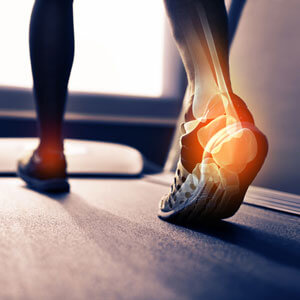Plantar Fascitis Treatment at Spine and Laser Center
Discover how custom orthotic insoles help to heal plantar fasciitis.
 Also known as “heel pain syndrome,” plantar fasciitis is the most common cause of heel pain, resulting from a gradual degeneration of the plantar fascia or sudden trauma to the area. Patients may describe the sensation as sharp stab or deep ache in the middle of the heel or along the bottom of the foot that typically occurs during walking or standing.
Also known as “heel pain syndrome,” plantar fasciitis is the most common cause of heel pain, resulting from a gradual degeneration of the plantar fascia or sudden trauma to the area. Patients may describe the sensation as sharp stab or deep ache in the middle of the heel or along the bottom of the foot that typically occurs during walking or standing.
Pain often occurs early in the morning, when taking your first few steps out of bed, or after other long periods of sitting/lying down/non-activity. As the foot naturally tightens at night, the fascia may gain new tears in the morning, initiating a painful cycle. Appearing in one heel or both, the condition tends to be chronic and can be difficult to heal without a combination of conservative treatments and persistence.
Causes
- Improper footwear
- Strenuous activity
- Obesity
- Over-pronation
- High arches or flat feet
- Poor shock absorption in shoes
Plantar fasciitis is commonly seen in middle-aged patients, but the young can be affected as well. We also see it often in those who place a great deal of stress on their feet like runners, athletes and soldiers. It affects approximately 2 million people in the United States annually.
Some doctors have the opinion bone spurs are the cause and surgery is required. Bone spurs are not the cause of plantar fasciitis. Surgery will not eliminate the pain, but may weaken or even rupture the plantar fascia!1

Symptoms
- Pain on the bottom of the heel
- Pain in the arch of the foot
- Pain that is usually worse upon arising
- Pain that increases over a period of months
- Swelling on the bottom of the heel
Treatment
In the Office
- Chiropractic adjustments to restore normal joint mechanics and reduce tension
- Custom-made orthotics to help hold the adjustments and position the foot for healing; use in all shoes for best results
- Rehabilitative exercises
At Home:
- Ice and massage on the sore area using a FootWheel® or a golf ball
- Running and walking on soft surfaces
- Rest
- Stretching the plantar fascia and the calf muscle area can help to prevent inflammation.
- Recommended Stretches: Taking a lunge position with the injured foot behind and keeping your heels flat on the floor, lean into a wall and bend the knees. A stretch should be felt in the sole and in the Achilles tendon area. Hold the stretch for 20-30 seconds. Also try this stretch with the back leg straight.
Prevention
Stretching before activity, maintaining a healthy weight and wearing supportive footwear all help with prevention. Custom orthotics are recommended to keep the foot in proper alignment and reduce stress on the plantar fascia.
Recovery
Recovery can be slow and requires patience, with 90% of patients recovering in 6-9 months. A combination of therapies as described above is the most effective approach.
CONTACT US »
Shoe Advice
Consider that the average American takes 5,900 steps in a single day. Wearing the right shoe is extremely important for the health of your feet-and the health of your whole body, too! Here is a quick reference guide for choosing shoes that are right for you…
- With a square or wide toe box
- With a heel lower than two inches high
- With 1/2 inch of space between your longest toe and the tip of the shoe
- With arch support (for all three of the foot’s arches, ideally)
- With wiggle room for toes–especially the big toe

- Too high heels (sorry ladies…If you MUST wear them, try to do so for no more than two hours at a time)
- Stiletto heels (awful for balance-if you’ve got to go with heels, choose chunky instead!)
- Pointy toed shoes (heels or otherwise)
- Flat-as-a-board footwear like many summer sandals (if you must, fit them with custom orthotics)
- Don’t go by size alone: different manufacturers size differently, plus the feet tend to grow larger as we age. With pregnancy, you can gain up to a size!
- Because the feet swell throughout the day-by up to 8%-do your shoe shopping toward the end of the day to ensure ample fit
Wearing custom orthotics in every pair of shoes goes a long way toward keeping you strong, healthy and pain-free.

